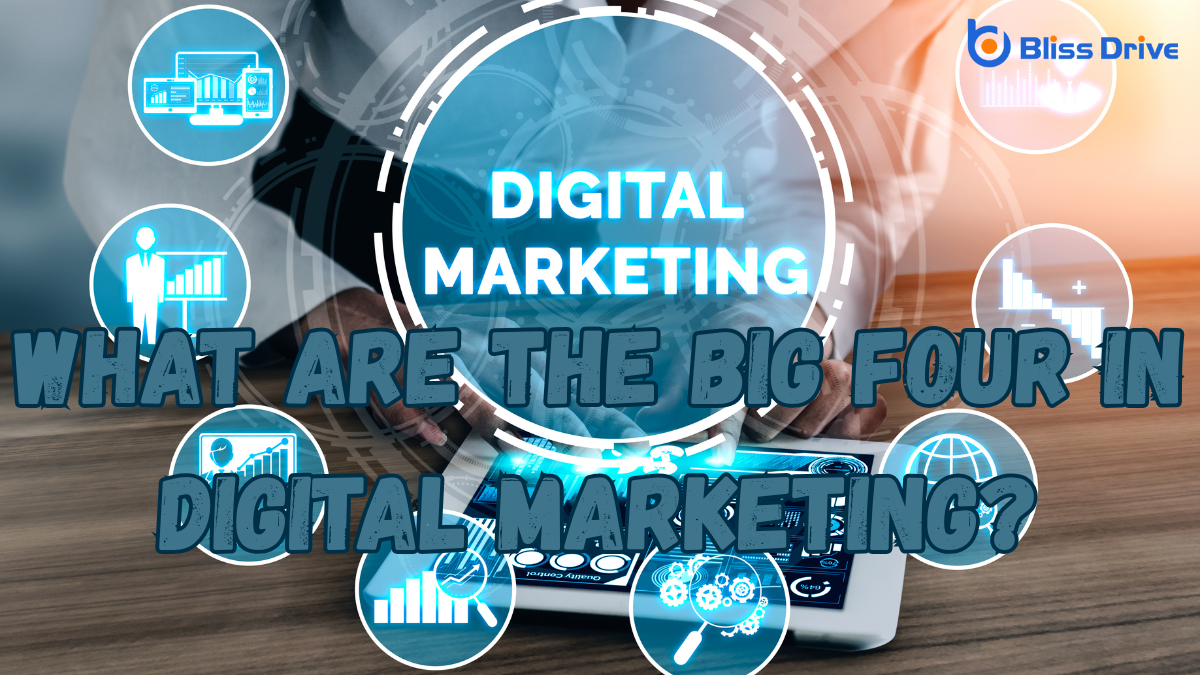Learn More About Us

When we talk about the big four in digital marketing, we're referring to the essential components that drive a successful online strategy: SEO, Content MarketingA strategic approach focused on creating and distributing valuable, relevant, and consistent content..., Social Media MarketingThe use of social media platforms to promote products or services, engage with audiences, and build ..., and Email MarketingThe use of email to promote products or services, build relationships with potential customers, and .... These elements work together to boost visibility, engage audiences, and foster conversions. But how exactly do they interact, and what makes each one indispensable? Let's explore how these pillars form the backbone of any effective digital marketing plan.
When it comes to digital marketing, understanding Search Engine Optimization (SEO) is essential for success. We all know that SEO is about improving our website's visibility on search engines like Google.
But how do we achieve this? First, we must focus on keywordsWords or phrases that users type into search engines to find information.. Identifying the right keywords that our target audience uses is vital. We should incorporate these naturally throughout our content.
Next, we need to pay attention to on-page elements such as titles, meta descriptions, and headers. These elements should be optimized to make our content more attractive to search engines.
Finally, let's not forget about backlinks. Quality backlinks from reputable sites boost our credibility and rankings.

While SEO enhances our visibility, content marketing plays an essential role in engaging and retaining our audience. We create valuable, relevant content that resonates with our readers, fostering trust and loyalty. By understanding their needs and addressing their pain points, we guarantee our content isn't just informative but also actionable.
Our content strategyA plan for creating, publishing, and managing content to meet business goals. involves crafting articles, videos, blogs, and more, tailored to our audience’s preferences. This approach helps us position ourselves as industry experts, encouraging our audience to return for more insights. Engaging content also encourages sharing, expanding our reach further.
Ultimately, content marketing is about building relationships. By consistently delivering high-quality content, we nurture a community that values our brand, turning readers into loyal customers over time.
Social media marketing has undeniably transformed how we connect with our audience, offering a dynamic platform to engage and interact in real time. We can share our brand's story, showcase products, and build a community around our values.
By leveraging platforms like Facebook, Instagram, and LinkedInA professional networking site used for career and business networking., we reach diverse demographics and tailor our messages to resonate deeply.
It’s essential to craft authentic content that reflects our brand's voice and encourages interaction. Engaging visuals, timely posts, and responding to comments can foster relationships and boost trust.
We should analyze metrics to understand what resonates, allowing us to refine our strategies. Let’s harness social media's potential to expand our reach and elevate engagementThe interactions that users have with a brand’s content on social media., ensuring our marketing efforts are both effective and meaningful.
As we explore the domain of email marketing, it's clear that this tool remains one of the most powerful ways to engage with our audience directly.
Crafting effective emails requires understanding our audience’s needs and preferences. We should personalize content, using segmentationThe process of dividing a market or customer base into distinct groups with similar characteristics.... to tailor messages to specific groups. By doing so, we enhance relevancy and engagement.
Timing also plays a critical role. Sending emails when our audience is most likely to open them increases the chances of interaction.
Let’s not forget the importance of a compelling subject lineThe heading or title of an email, designed to entice recipients to open it.—our gateway to capturing attention. Including clear calls-to-action guides readers toward desired outcomes.
Finally, we should always analyze the results. Tracking open ratesThe percentage of recipients who open an email. and click-through rates helps us refine our strategy for better performance.

Let's explore how we can combine strategies from the Big Four to maximize our digital marketing efforts.
By integrating these key components, we'll enhance our digital synergy and create a more cohesive approach.
Together, we'll access new potential for success in our campaigns.
When we integrate the Big Four in digital marketing—SEO, content marketing, social media marketing, and paid advertising—we unleash a powerful synergy that enhances each strategy's effectiveness.
By combining these strategies, we guarantee our message reaches the right audience at the right time. For instance, we can optimize content for search engines to increase visibility while using social media to engage and build relationships.
Paid advertising then amplifies our reach, bringing in targeted traffic. Each component supports the others, creating a cohesive and efficient marketing plan.
Our goal is to create a seamless experience for our audience, guiding them from awareness to conversionThe completion of a desired action by a referred user, such as making a purchase or filling out a fo.... By strategically aligning these elements, we maximize impact and guarantee our digital marketing efforts leadA potential customer referred by an affiliate who has shown interest in the product or service but h... to success.
To truly enhance digital synergy, we must seamlessly integrate the Big Four—SEO, content marketing, social media marketing, and paid advertising—into our marketing efforts. Each component plays a crucial role, but their collective power drives maximum impact.
By aligning these strategies, we create a more cohesive and effective marketing approach. Here's how we can achieve this:
As we navigate the digital marketing landscape, let's be mindful of common pitfalls like overcomplicating our campaignA set of ad groups sharing a budget, targeting options, and other settings. strategies.
It's essential to stay focused on our target audience's needs and not lose sight of the valuable insights data can offerThe specific product or service being promoted by affiliates..
Although digital marketing offers endless possibilities, one common pitfall is overcomplicating campaign strategies. It’s easy to get caught up in the latest trends and tools, but we must remember that simplicity often leads to success.
Let’s focus on avoiding complexity by considering these key points:
Understanding our target audience is essential for any successful digital marketing campaign, yet many of us make the mistake of overlooking this important component.
We might assume we understand what our audience wants, but without truly grasping their needs, preferences, and behaviors, our efforts can fall flat. When we ignore their needs, our messages may miss the mark, leading to low engagement and poor results.
We need to prioritize audience research to tailor our content and strategies effectively. Let’s ask ourselves: Who are we trying to reach? What problems do they face? How can our products or services provide solutions?
While understanding our target audience is paramount, we must also harness the power of data to inform our strategies. Neglecting data-driven insights can lead us astray in today's competitive digital landscape.
By embracing data, we can make informed decisions that enhance our marketing efforts. Here are three common mistakes to avoid:
Evaluating the performance of our digital marketing efforts is essential for refining strategies and maximizing returns. When we measure success, we need to focus on key performance indicators (KPIs) like conversion rates, click-through rates, and return on investment (ROI)A measure of the profitability of an investment, calculated by dividing the net profit by the cost o....
These metrics help us understand what’s working and where we need improvement. Let’s not forget about the importance of customer engagementThe level of interaction and involvement a customer has with a brand. and brand awareness, which can be gauged through social media metricsQuantitative measurements used to gauge the effectiveness of social media marketing efforts. and web trafficThe number of visitors to a website, often used as a measure of an affiliate's reach and influence. analysis.
We must use analytics toolsSoftware used to track and analyze website performance, user behavior, and marketing efforts. to track these metrics effectively. By doing so, we guarantee our strategies align with our goals and adapt to changing needs.
Regularly reviewing these insights allows us to make informed decisions, optimize campaigns, and ultimately drive better results for our digital marketing efforts.

How do we stay ahead in the ever-evolving landscape of digital marketing? We need to adapt swiftly to emerging trends and technologies to maintain our competitive edge.
Let’s explore some key actions:
1. Continuous Learning: We must regularly educate ourselves on industry shifts.
Attending webinarsLive or recorded online presentations or seminars used to educate and engage an audience., reading articles, and taking online courses keep us informed and ready for change.
2. Embrace Innovation: Adopting new tools and technologies can drive better results.
Whether it's AI-driven analytics or the latest social media platform, being open to innovation helps us reach our audience effectively.
3. Monitor Competitors: Keeping an eye on competitors' strategies offers insights into what's working within our industry.
This awareness allows us to refine our approaches and stay relevant.
To build a future-ready digital marketing strategy, we must anticipate shifts in consumer behavior and technological advancements. By staying informed, we can adapt and thrive in a constantly evolving landscape.
First, let’s focus on data analytics. Leveraging data helps us understand trends and make informed decisions.
Next, embracing AI and automationUsing software to send emails automatically based on predefined triggers and schedules. can enhance personalizationTailoring content and offers to individual users based on their behavior, preferences, or demographi..., making interactions smoother and more relevant. Additionally, adopting a mobile-first approach guarantees our content reaches users effectively, wherever they are.
We also need to prioritize ethical practices, fostering trust and transparency with our audience.
Regularly reviewing and adjusting our strategies is essential to remaining agile. By being proactive and open to change, we’re better equipped to meet future challenges and seize new opportunities in digital marketing.
To summarize, we've explored the Big Four pillars of digital marketing: SEO, Content Marketing, Social Media Marketing, and Email Marketing. By effectively integrating these elements, we can create a dynamic strategy that boosts awareness, engagement, and conversions. Let’s remember to avoid common pitfalls, measure our success, and stay adaptable to emerging trends and technologies. Together, we'll build a future-ready digital marketing strategy that keeps us ahead of the curve and drives our success.
